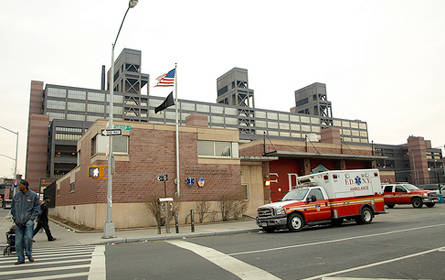Public Hospitals in Critical Condition
Four clinics are set to shut, four mental health programs in New York City public schools won't be around next year, and three satellite pharmacies are about to fill their last prescriptions.
These are just some of the measures the city's Health and Hospitals Corp. is taking to address a budget hole that could grow to $1 billion in 2010. And more cuts are coming, said corporation President Alan Aviles.
Call it a side effect of being a public hospital system, but the Health and Hospitals Corp. has been consumed by a tsunami of unfortunate fiscal tidings. Several detrimental cuts from the state (the state's Department of Health argues otherwise) and a steady rise in the uninsured, corporation officials said, has forced the 11-hospital network and its scores of outpatient clinics to restructure -- floating the possibility of a consolidation of services and additional clinic closures.
At a City Council budget hearing Wednesday, Aviles said the corporation is grappling with how to close a $316 million budget gap for this year alone. It has already earmarked measures, such as closing clinics in Sunnyside and Springfield Gardens in Queens, a clinic in the High Bridge section of the Bronx and another in Sheepshead Bay in Brooklyn, which would save $105 million. Additional budget actions, Aviles said, are under review.
But the corporation faces structural, long-term fiscal problems that its leaders attribute to restructured state Medicaid reimbursement rates, unreliable federal funding streams and a growing population of patients who can't afford to pay. The cuts alone will not remedy those problems.
Dire Straits
No one can deny the city's public hospital system, which sees 1.3 million New Yorkers a year, is in critical fiscal condition.
"HHC has problems in the few hundred million at the moment because of the state cuts, but when you look at its financial plan going out, its problems are in the billion dollar range," said Mark Page, the director of the city's Office of Management and Budget at a recent City Council hearing. "And how that gets addressed in the next few years, I think it's going to be a huge challenge for New York City and HHC."
Not surprisingly, it is difficult to determine who is to blame. The corporation, say officials, is pointing at the state, specifically its revision of Medicaid reimbursement rates and its distribution of federal Medicaid funding streams, including money it received from the federal stimulus package.
The Health and Hospitals Corp. says it lost out.
"The state has discretion with those dollars, and they were largely used for gap closing," said Aviles of the state's own budget woes. "They were certainly not used to offset further cuts (at the Health and Hospitals Corp.)."
With the aim of restructuring its rates for reimbursing hospitals, clinics and doctors for treating low-income Medicaid patients -- a calculation that still relied on figures from the 1980s -- the state, over the course of two years, approved new formulas for the disbursement of Medicaid dollars. The new formulas, according to state officials, would not only bring the reimbursement rates up to date, but also reflect the type of care New York's patients actually received. State health department officials said the state had been overpaying for inpatient care and underpaying for outpatient care as the health industry refocused its concentration on preventative medicine. Under the new rates, say state officials, the corporation could take advantage of higher outpatient rates by moving some procedures to their clinics.
The implication of the new rates, said Deborah Bachrach, deputy commissioner for the Office of Health Insurance Programs at the state Department of Health, was a hospital would get paid more if it did more. The state, she said, should not pay the same rate to clog a nosebleed that it pays for cardiac care.
"Our first obligation is to get people covered," said Bachrach. "And the second obligation is to buy the right care in the right setting at the right price."
The Health and Hospitals Corp. does not see the revision that way. Aviles told the City Council that the corporation would lose $45 million in Medicaid funding this year, $109 million in the next fiscal year and $150 million in fiscal year 2011.
Much of the corporation's funding comes from two other Medicaid federal funding streams, which are distributed by the state. This year, the corporation has received about $416 million so far from these streams, according to corporation officials, half the annual $838 million it received, on average, over the past five years. More is likely to come from the federal government later this year, Aviles said.
The state does not contribute to at least $300 million of that Medicaid funding. Half is from Washington, and the other half is from the city.
The corporation's primary patient population is poor and uninsured, and under its charter, it can turn no one away. Meanwhile, the number of uninsured patients continues to rise, increasing 8 percent from 2007 to 2008. This makes it particularly dependent on outside funding streams and government subsidies.
Of the corporation's $6.7 billion budget, little comes from city tax dollars -- about $89 million. That too could be cut by $3.5 million, according to the mayor's executive budget proposal, threatening child health clinics.
Who to Turn To?
At a budget hearing on Wednesday, Councilmember Helen Sears sang the corporation's praises.
"How do you get through these state cuts and federal cuts?" the Queens legislator asked. "Your cuts get deeper and deeper and you manage to give quality care."
Some fear that will not happen for long.
As other nonprofit, private hospitals across the city close their doors, like Mary Immaculate Hospital and St. John's Queens Hospital, City Council members fear patients will inundate the corporation's facilities, further taxing the system.
"They are incredibly important part of the safety net in New York City and anything that is happening that is going to push them to reduce their ability to serve uninsured people in their outpatient departments is going to be devastating," said Elizabeth Swain, chief executive officer of the Community Health Care Association of New York.
As for the city, a Bloomberg administration spokesperson said in an e-mailed statement: "HHC faces fiscal challenges as most healthcare providers do and addressing these challenges will likely involve the corporation, the city, the state and the federal government -- at a time when needed reforms of the health care system are a national topic of much debate."
In 2004, Mayor Michael Bloomberg allocated $200 million to the city's public hospitals to help reverse year's of neglect by the Giuliani administration. It's unlikely they would do the same again with their own fiscal problems. Overall, both the administration and the council have little influence over the structural deficit the corporation faces.
Currently, the corporation is pressuring city officials to lobby state legislators for funding to stave off the budget gaps down the line. That will not halt their current restructuring, which, Aviles said, would most definitely result in a drop in services.
"It will require looking at the traditional approach that all hospitals can be all things to every community," said Aviles. "To some extent we may have to consolidate some of our services in some of our facilities so that we can maintain those essential services and access to those services, but deliver them as efficiently as possible."
City, State Do Little to Address Female Genital Cutting

Image by Gotham Gazette
For Angela Montague, it began with a young woman from the West African country of Guinea. In February 2008, Montague, a licensed clinical social worker and the assistant director of social work at the Metropolitan Hospital Center in East Harlem, received a referral from a doctor in the hospital's family planning clinic. A 19-year-old patient had come in complaining of abdominal pain and then broke down crying.
The young woman traced her physical and emotional pain to when she was 8 years old and the women in her community in Guinea had gathered to perform a rite of passage on her - namely, cutting off her clitoris.
"She came to see me the same day as her physical exam," Montague said. "She was clearly experiencing symptoms of post traumatic stress disorder. She had regular nightmares about the day she was cut, and she had difficulty concentrating because the memories would continually resurface. She even feared groups of people because it reminded her of the group of women who held her down while the cutting was performed."
Known alternately as female genital cutting (FGC) or female genital mutilation (FGM), the removal of all or part of the external female genitalia is practiced across cultures and religions in parts of Africa, Asia and the Middle East. It is generally performed by women on girls as part of the transition to adulthood. The World Health Organization estimates that between 100 million and 140 million women and girls worldwide have undergone FGC. In the United States, estimates suggest that the number of women and girls who have undergone FGC or who are at risk grew by about 35 percent between 1990 and 2000 - from 168,000 to 228,000. The New York metropolitan area is estimated to have the highest number of women and girls affected by or at risk of undergoing genital cutting in the United States: just under 41,000, according to estimates based on data from the 2000 census.
Montague saw the young woman regularly for counseling and began to receive referrals of other women in New York experiencing similar problems. When she spoke to her colleagues throughout the city about genital cutting, she discovered that many of them were not aware of the issue and that education on the health consequences of the practice was limited. And while some individual service providers were working to support women and girls who had undergone cutting, a comprehensive structure for addressing the issue remained unrealized at both the state and federal levels.
In fact, neither the city nor the state government has taken concrete steps to address the practice or its effects, which can range from post-traumatic stress disorder to severe infections, painful menstruation and complications during pregnancy and childbirth.
What the Government Is Not Doing
New York is one of 17 states that have passed legislation criminalizing the practice of FGC on minors. The state law, which is modeled on federal legislation that was also enacted in the mid-1990s, identifies both the person who performs the cutting as well as the parent or guardian who consents to it as being "guilty of female genital mutilation."
The law also required the state Departments of Health and Social Services (now the Office of Children and Family Services) to establish "education, preventive and outreach" activities in communities that traditionally practice FGC in order to inform them of the health consequences of the practice and the provisions of the state law.
Very little has been done, however, to implement either part of the law. The last sustained education and outreach activities took place 10 years ago in collaboration with the women's advocacy organization RAINBO, said Mary Applegate, who coordinated the project when she was the medical director in the New York State Department of Health's Bureau of Women's Health. The bureau's current women's health coordinator, Margaret Allen, said that she is not aware of any ongoing activities on FGC at the state level.
The New York City Health Department also reported that they have no information on FGC.
A bill that is currently before the New York Senate Health Committee would require the state Department of Health and the Office of Children and Family Services to produce an annual report to the governor and state legislature on their activities addressing FGC. Versions of the bill have been making their way through the Assembly since 1995 but have repeatedly died in the Senate. The bill was reintroduced in January 2009 by Assemblywoman Barbara Clark of Queens.
"As far as we know, the state is not undertaking activities to address this issue," said Jessica Gormand, Clark's legislative director. "Part of the motivation for putting this bill forward was to bring this to light."
And on the law enforcement side, no criminal case has ever been brought using the New York law, or other state and federal laws, on genital cutting, said Taina Bien-Aimé, executive director of the human rights organization Equality Now, which works to end the practice worldwide.
The lack of activity in the state mirrors the situation at the federal level. Federal law also criminalizes the practice of FGC on minors and charges the Department of Health and Human Services with conducting outreach and education to communities and service providers. The department worked with RAINBO to produce and distribute a curriculum for health care providers on FGC in the late 1990s and held a few community workshops, but no regular activities have taken place since 2000, said Wanda Jones, deputy assistant secretary for health and director of the department's Office on Women's Health.
The small amount of funding that was allocated to these activities in the 1990s also has largely disappeared, Jones added.
The lack of government activities on FGC in the United States comes at a time when governments in Africa and Europe are stepping up their efforts to prevent and respond to cases of FGC through legislation and targeted social services, said Bien-Aimé.
"The United States has fallen behind many European and African countries in addressing female genital mutilation," she said. "There is a fundamental ignorance on the issue and a limited political will to recognize that girls are at risk here."
A Grassroots Effort
Without leadership or resources from the city, state or federal government, a handful of community-based organizations, like Sauti Yetu Center for African Women in New York, and individual service providers like Montague have taken on much of the work of preventing FGC here and responding to its effects.
In New York, Sauti Yetu is the only community-based nonprofit working specifically on FGC, said Asmaa Donahue, senior program officer at Sauti Yetu.
As part of its response efforts, Sauti Yetu trains health-care professionals, medical students and social service providers working with African communities to give medically appropriate and culturally sensitive care to women who have undergone FGC. In many cases, service providers who come across FGC in their work will also approach Sauti Yetu to develop a partnership. Montague, for example, worked with Sauti Yetu earlier this year to organize a panel on FGC and medical care at Metropolitan Hospital Center, and she is also working with them to organize a session on FGC for the hospital's staff.
At the federal level, Health and Human Services has begun to re-engage with community activists and service providers to see how the federal government might support prevention and response efforts, said Jones. In 2006 and 2007, for example, the department's Region II Office of Women's Health, which includes New York, participated in meetings organized by Sauti Yetu to discuss gaps in addressing FGC in the region. The participants included state department of health officials, nonprofit organizations working on reproductive health and sexual violence, and women from immigrant communities. Sauti Yetu also continues to lobby the federal government for funding to support community-based work on FGC, said Donahue.
There are currently very few organizations spearheading prevention efforts in the United States. Organizations such as Equality Now and the Tahirih Justice Center near Washington, D.C. seek to raise public awareness and support women and girls seeking asylum due to the threat of FGC in their home countries.
At the local level, Sauti Yetu engages communities in discussion about the practice and is cultivating a network of African women working to end FGC in their own communities. The New York area, though, does not yet have many vocal, grassroots advocates on this issue, said Donahue.
Several service providers noted that prevention efforts can be successful only when the communities are involved as leaders.
"Activism in the 1990s focused on criminalizing FGC, and communities [that traditionally practice FGC] were left out of the policy conversation. This led to a backlash," said Donahue. "They saw themselves being portrayed as barbaric in the media and they felt under attack. Women felt stigmatized rather than empowered to address the issue."
Service providers fear that a renewed focus on law enforcement could drive the issue further underground and prevent women and girls from seeking help either to prevent FGC or to address its effects, said Jones.
Still, at both the federal and state levels, little promises to change soon. FGC does not appear to be on the agenda of relevant state or city agencies in New York, and in a city of millions, an issue facing thousands of immigrant and refugee women and girls can easily remain marginalized. Despite the numbers, though, the need to address the practice remains.
"New York is a city of immigrants so service providers have to be prepared to provide culturally sensitive and appropriate services on practices like FGC," said Montague. "These women need a safe place to go."
Alyson Zureick is a freelance writer based in New York.
Council Takes a Bite Out of Bed Bugs

Photo from wiki commons
The City Council tried to bite bed bugs back Wednesday when it unanimously approved legislation spurring the city to investigate the epidemic.
The bill requires the city form a task force to make recommendations on how to stop infestations currently ravaging apartments citywide.
The council also approved legislation requiring the registration of debt collectors, the reinstatement of a waterfront advisory board and an increase in fees for waste transfer station operators.
Banning Bed Bugs
They crawl through walls, from apartment to apartment, devastating buildings and sometimes blocks. Bed bugs, which the city thought pesticides had vanquished decades ago, are making a comeback.
In an attempt to exterminate them, the City Council approved legislation (Intro 57-A) that sets up a bed bugs task force to investigate infestation trends and draft recommendations to eradicate the pests. The bill, sponsored by Councilmember Gale Brewer, was pared down during the legislative process. It had initially banned the sale of restored mattresses.
The epidemic has grown in the city over the last few years, said Brewer. According to the council, there were 377 bedbug-related violations in 2004, compared to two in 2002. Last year, Brewer said, the city conducted 9,000 housing inspections related to bed bugs.
"Getting bed bugs is a personal nightmare," said Brewer. "It's a financial nightmare."
Infestations aren't deadly, but they can ruin furniture, especially mattresses, and can prove very costly.
The task force will include representatives from the departments of consumer affairs, health and mental hygiene, sanitation, information technology and communications, and housing preservation. It will also have an exterminator, entomologist and community health professional on board.
The task force will look into infestation treatments, tracking, disposal of infested items, and training and education for pest management professionals, city employees and the general public.
Council Speaker Christine Quinn said this would not be the last bill the council votes on regarding bed bug infestations.
Another bill currently under consideration by the council would require that old mattresses be put in plastic bags when thrown out.
Buying Debt
Purchasers of second-hand debt will now be required to register with the Department of Consumer Affairs and follow the city's collection regulations under legislation passed unanimously by the City Council.
The vote was 46 to 0.
The bill ( Intro 660), sponsored by Councilmember Daniel Garodnick, is in part a response to a 70 percent increase in complaints to the Department of Consumer Affairs between 2006 and 2008. Garodnick said the number one topic of complaint at the department is unlicensed debt collectors.
Spurred by the current financial crisis, agencies have purchased debt from licensed collection companies, but they have failed to get registered themselves, Garodnick said. This creates confusion for the consumer, who is all of a sudden receiving collection notices, phone calls and even court summonses from an unfamiliar agency.
These collectors have made an industry out of buying debt, said Councilmember Leroy Comrie, the chair of the council's consumer affairs committee.
In addition to requiring registration, Garodnick said, the bill will force the debt collectors to identify the original creditor, itemize the money owed, provide background information on the obligation and give confirmation in writing when the debt is settled to avoid consumers being charged with collections twice.
Garodnick said 300,000 debt cases have been brought against New Yorkers.
Protecting the Waterfront
To revive an agency that has been defunct since the Dinkins administration, the council approved legislation ( Intro 867-A ) reauthorizing the formation of a waterfront advisory board.
The board will be charged with reporting to the council and the mayor twice annually with recommendations on how to better utilize the city's 578 miles of waterfront. The board will be required to look into recreational use of the waterfront.
Increasing Waste Fees
The City Council approved legislation ( Intro 840) to raise fees for permits for operators of waste transfer stations.
For more on solid waste management in the city play The Garbage Game.
The city will increase fees for operators at non-decomposable waste sites from $3,500 to $7,000 annually. For station operators who deal with decomposable waste, annual fees will be raised from $6,500 to $13,000. Fees have not been raised in two decades, according to the council.
The legislation would also create a $7,000 fee for solid waste container facilities that operate two forms of transportation, such as both truck and rail.
A Food Policy for New York

Photo (cc) the T bone
Increasing the availability fresh produce, like these apples at Union Square Greenmarket, is one small piece of New York's public health policy.
Food policy, nutrition and public health have played a central and often contentious role in the Bloomberg administration's agenda for the city. Achieving the goal of a healthier New York City has led the mayor to employ both legislation and executive order. Now Manhattan Borough President Scott Stringer has joined the push to increase the availability of healthy foods such as fruits and vegetables in an effort to improve public health.
"We need a paradigm shift in the way New York thinks about food. For too long, decisions about food have been made on the federal level or by private parties," Stringer said.
The city's food and public health policy has had three major parts: increasing the availability of healthy food, reducing the prevalence of unhealthy food and adjusting the public's behavior so people eat a better diet. Stringer's proposal takes a larger scope than previous initiatives and offers a comprehensive plan for the city. The report focuses on using tools such as zoning and tax abatements to ensure the city's "food security" and eradicating its "food deserts."
Neighborhood Food Shortages
In April 2008 the Department of City Planning issued a report detailing the intersection of demographics, geography, food policy and public health. It concluded areas underserved by retailers selling fresh food, such as the Bronx, central and eastern Brooklyn, far eastern Queens and Harlem, have above average rates of diet related diseases.
Currently, an estimated 3 million New Yorkers live in "high-need neighborhoods," defined by a lack of supermarkets and a prevalence of diet-related health problems. These areas lack food security, meaning that people who live in them have difficulty getting "nutritious and affordable food." An estimated 750,000 city residents live in "food deserts" -- areas more than five blocks from a supermarket. Often food deserts are located in low-income and minority communities with a prevalence of diet-related disease, such as obesity and diabetes.
Increasing rents and tight profit margins have led to a wave of supermarket closings across the city, exacerbating existing problems. Many of the supermarkets have been replaced with drug stores, which sell the unhealthy foods at the root of weight-related health problems as well as the medications used to treat them. Pharmacies, convenience stores and discount stores, which sell processed foods, have become the primary food retailers in some neighborhoods.
The city has taken several steps to reverse this trend, including the healthy bodegas initiative, which tries to encourage the small neighborhood stores to stock low and reduced fat milk as well as fruits and vegetables. In February 2008, City Council passed the Green Carts bill to allow more mobile fruit and vegetable vendors in low-income neighborhoods. Bloomberg and City Council Speaker Christine Quinn put forward the bill as part of the effort to make New York City healthier.
Stringer would build on these efforts. Under his report's recommendations, the city would continue to look at approaches to making fresh produce available outside of the traditional grocery stores and supermarkets, but also would take a more active approach to increasing the availability of healthy foods. He recommends the city create "food enterprise zones" to attract food retailers to underserved areas through zoning and tax incentives. The plan calls for public financing or micro loans to community food partnerships, allowing food vendors tax abatements under the Industrial and Commercial Abatement Program and exempting vendors from business taxes. It also suggested the New York City Housing Authority make provisions for food retailers in public projects.
Zoning for Food

Photo (cc) specialklikethecereal
Zoning regulations offer another policy option to increase the number of retailers selling healthy foods and stem the tide of closing supermarkets. The report suggests government agencies develop an integrated plan for city support of supermarkets, adjust land-use regulations influencing supermarkets, consider supermarkets' need during future rezoning and evaluate the possibility of supermarkets on city owned property. For example, the city might categorize retailers selling fresh fruits and differently from general food stores and so provide them with a density bonus or a permit for additional floor area exemption, according to Stringer.
Other officials have proposed ideas to discourage less nutritious fare. Bloomberg ordered that city restaurants stop selling food containing transfats and now reportedly is considering ways to reduce the sodium content in prepared and processed foods. In his budget for the coming year, Gov. David Paterson called for an 18 percent tax on sugary drinks, although the idea appears unlikely to pass.
City Councilmember Joel Rivera had suggested capping the number of fast-food restaurants through changed zoning laws. The idea did not go anywhere here, but last year, the Los Angeles City Council unanimously passed a bill to place a one-year moratorium on the development of new fast-food restaurants in South Los Angeles, a low-income minority area that has double the obesity rate of the city's wealthier areas. The legislation is intended to allow for the development of restaurants that serve healthier food and is confined to an area of the city with high instances diet related problems.
While the borough president's office indicated it would be open to explore restricting the proliferation of fast food restaurants, people there point out that any effort to limit fast food outlets must be supplemented with a drive to increase the number of healthy food outlets. Instead, Stringer's report emphasizes more market-oriented approaches to improve the city's food options.
For one, the borough president's office proposes eliminating tax subsidies for fast food restaurants. "We'll give you a tax abatement if your store sells Big Macs but not if you just sell the lettuce and tomato. It's time for government to step up to change how we approach the city's dinner plate," Stringer said.
The Industrial and Commercial Incentive Program was intended to keep businesses in New York City by offering a tax abatement or tax exemption for increased property value, which would gradually be incorporated over time.
In October 2008 the Industrial and Commercial Incentive Program was replaced by the Industrial and Commercial Abatement Program, which puts more restrictions on the incentives. It limits the areas in which businesses can receive benefits -- firms in a large part of Manhattan can no longer qualify -- but it does not go far enough for some who believe the incentives tip the commercial playing field toward big corporations who sell unhealthy food.
"It was great that in midtown Manhattan it was basically eliminated," said Allison Lack of Good Jobs New York, a public interest group. But, she continued, retail projects, including national fast-food restaurants, are still eligible for tax abatements in Harlem, the South Bronx and Central Brooklyn, areas that are low-income, minority and afflicted with above average rates of diet-related health problems. Stringer would like to see the programs updated to prevent national fast food chains, such as McDonald's and Dunkin' Donuts, from benefiting.
Supermarkets and grocery stores also are eligible for tax abatements, but despite this many have not applied. "Some have and some haven't," said Lack. Good Jobs New York has not yet been able to determine why more retailers have not taken advantage of the program. "We really don't know. It's something we're looking into," said Lack.
Any effort to limit, restrict or inhibit the fast-food industry would meet resistance. Fast food restaurants constitute a powerful lobby. Subsidies given to producers of unhealthy food have increased the amount these companies spend on advertising and lobbying, giving them an even more outsized influence on food choices. But as obesity and diabetes rates rise -- and the costs placed on government increase -- a number of city offices are looking to end the Big Mad attack.
Know Your Invasive Critters
|
QUAKER PARROT Myiopsitta monachus Also known as: Quaker Parakeet, Monk Parakeet Native home: Argentina Came to U.S.: Through Kennedy airport Threat: Utility companies say the birds' huge nests can threaten electricity transmission and even lead to blackouts. Government action: In New York, Con Ed has tried to dismantle nests and has discussed building platforms to entice the birds away from power lines. Other states, though, have adopted more draconian measures. |
|
COMMON REED Phragmites australis Native home: North America How it got here: The opportunistic reed has spread everywhere. While degradation of wetlands gets much of the blame, some scientists believe a hardier strain of the plant, native to Europe, may be adding to the problem. Threat: Crowds out other plants, depriving birds of plants needed for feeeding and nesting. Government action: The city has a plan to reduce some nitrogen discharges into marshes. Many environmentalists believe the city must adopt other measures to protect its wetlands from phragmites and other threats. |
|
ZEBRA MUSSEL Dreissena polymorpha Native home: Russia and European waterways How it got here: Commercial fishing boats and cargo ships transfer foreign species like the zebra mussel to new waters by dumping contaminated ballast water. Threat: In addition to making some native species nearly extinct, zebra mussels colonies can be so dense that they clog intake pipes at water and power plants. They have also contaminated the water at treatment facilities. Some argue, though, they aren't all bad, because they consume bacteria and decrease water contamination. Government action: As of Sept. 30, thanks to a lawsuit brought by New York and several other states against the Environmental Protection Agency, it will be illegal for ships to dump untreated ballast water. A bill regulating the cleanliness of ballast water is stalled in the U.S. Senate. |
|
WEST NILE VIRUS Virus of the family Flaviviridae Native home: First detected in Uganda in 1937, later found elsewhere in Africa, the Middle East and Europe. How it got here: Believed to have come in through LaGuardia airport, possibly in a mosquito or infected passenger. Threat: An encephalitis disease, it can make people very sick and can be fatal, particularly for the elderly or people with compromised immune systems. It has also killed many birds and can affect other animals as well. Government action: Use of insecticides to kill mosquitoes and their larvae. Public education campaigns to help people avoid mosquito bites and remove standing sources of water. |
|
BED BUG Cimex lectularius Native home: Europe How it got here: Brought by early colonists from Europe. Threat: They bite! Severe infestations can mean the loss of mattresses, furniture, clothing, etc., because the pests are so tricky to eradicate. Government action: The City Council is considering legislation that would require used mattresses be labeled and put in plastic bags when discarded. The city can fine landlords for bed bugs, and the state is considering a bill that requires the notification of parents when an infestation occurs at school. |
|
DUTCH ELM Ophiostoma novo-ulmi Native home: Asia How it got here: Came on imported timber in 1928. Threat: A fungus-caused and beetle-borne disease that can kill entire elm trees. It can also spread from one tree’s roots to another’s if two trees are close together. Government action: Thirty-five elms in Central Park have been infected, and 21 eradicated. The Central Park Conservancy has spent over $150,000 handling the problem, the site says. Containing the disease involves injecting fungicide in tree trunks, pruning affected branches and removing trees that are beyond salvation. |
|
ASIAN LONGHORN BEETLE Anoplophora glabripennis Native home: China How it got here: Believed to have come via shipping crates. Threat: The beetle, which was first found in the city in Greenpoint in 1996, can kill large swaths of hardwood, deciduous trees after laying eggs in their bark. They have been found in every borough, except the Bronx, and commonly attack maple, horsechestnut, elm, willow, birch, poplar, and ash trees. Government action: The city has established quarantined zones where infested trees are removed and chipped. These trees cannot be picked up with the rest of a resident's trash. |
|
NORTHERN SNAKEHEAD FISH Channa argus Also known as: Frankenfish Native home: China How it got here: unclear, but first discovered in Maryland, May 2002 Threat: According to a U.S. Fish and Wildlife Service news release, snakeheads are “voracious eating machines” that can ravage the natural balance of any freshwater environment. Government Action: The federal government banned snakeheads and their eggs in 2002. In New York, recent infestations have taken over the river system in Orange County’s Ridgebury Lake area. Residents are working with the state’s Department of Environmental Conservation to flush the river with Rotenone, a low-toxic pesticide, and clear the river of all fish in an effort to stop the snakehead’s proliferation. |
Back to Invasion New York
Those Restaurant Calorie Counts: Too Good to Be True?

Some snack items pack in a meal's worth of calories.
Five hundred and ten calories in a corn muffin at Dunkin' Donuts? One thousand one hundred and fifty calories in a Garden Omelet at IHOP? And 2,210 calories in a Bloomin' Onion appetizer at Outback Steakhouse?
"It's shocking," said Loreta Gemeviciute of Manhattan, who used to buy Starbucks' Venti Mocha Frappuccinos until she glanced at their 500-calorie stats. "I could eat a whole, good meal for that many calories."
Since calorie counts appeared on menus across the city, New Yorkers have feasted on the cornucopia of data. Some consumers can hardly believe their eyes.
And perhaps they shouldn't.
The rule that went into effect on March 31 requires restaurants with 15 or more franchises nation-wide to post calorie data on menus. Concerned about the city's obesity epidemic, the Board of Health reasoned that people might shun some foods in favor of healthier ones if they knew just how many calories lurked beneath a Big Mac's special sauce and sesame seed bun. But while mandating that calorie data be displayed, the law does not address many issues surrounding the accuracy of the counts. Many nutritionists laud the city's efforts to help New Yorkers eat better, but critics say the law was hastily crafted and will be impossible to enforce.
Meanwhile, consumers will need to realize that all calorie counts are not created equal. Calorie data on New York's menus are subject to far less scrutiny than the nutrition labels on products sold in grocery stores.
For one thing, the calorie content of meals made to order can vary significantly, even at restaurants with standardized preparation methods.
"That's the trouble with food - you can't really get it down to a science when it's made to order," said Marissa Lippert, a registered dietician in Manhattan. "At a mid-level restaurant, will every single chicken breast be three ounces? Probably not. That could make a big difference."
When food preparers toss in a little extra cheese or a little more oil, nutrition data can be thrown off by hundreds of calories. Just ask Quanisha Stackhouse, who works at Nathan's.
"My small fries look like medium fries and my medium fries look like large fries," she said. "I figure if they're paying $7 for a meal, people want to get their money's worth. I've got extra bacon in the salads, extra everything."
So when it comes to calories on the plate and calories on the menu, how close is close enough?
The federal regulation concerning calorie counts on food sold in stores requires the number on the label be within 20 percent of the food's actual content. The New York City law, however, does not specify a degree of precision.
"It's indeed a rather extensive loophole," said Chuck Hunt, executive vice president at the New York State Restaurant Association. The association has challenged the rule in court, claiming it conflicts with federal regulations and violates the commercial free speech rights of the food companies.
Proponents of the law argue that restaurant menus usually fall within the ballpark of accuracy. But lab analysis of calorie claims has shown that restaurants' nutrition totals can be wildly inaccurate, even in the case of major chains.
When the Center for Science in the Public Interest, an advocacy group for nutrition and health, independently tested Olive Garden's calorie claims, it found major discrepancies. The chain's cappellini pomodoro, posted as under 640 calories, had 990 calories, or 55 percent more calories than stated.
Similar discrepancies surfaced when ABC2 News investigated meals at Taco Bell, Macaroni Grill, Cheesecake Factory and other restaurants. Macaroni Grill's "Skinny Chicken" meal, posted as 500 calories, came out as 1022 calories, more than twice the stated calories. Most dishes tested in the ABC2 News experiment also showed significant inaccuracies.
Policing The Menu Boards

The rainbow cookie at Starbucks - an accurate calculation?
Under the new regulation, city restaurants will largely be taken at their word that the calorie totals they present are accurate. Unlike the federal Food and Drug Administration, the city has no system to police calorie labels.
"We will take appropriate action if we receive complaints; we haven't conducted any testing to date," said Jessica Scaperotti, press secretary for the city health department.
There is also no systematic testing to ensure that restaurants are not miscalculating - or misrepresenting - their data, according to the health department. In contrast, the FDA has complex procedures to test for accuracy under its food safety program.
"FDA inspections are risk based, meaning firms with a history of safety violations get inspected more than those that don't," said Michael Herndon, a spokesman for the agency. "And routine inspections are conducted."
Like the city, the FDA allows food manufacturers to compute their own calorie data, using lab analysis or other methods. But the FDA collects nutrition labels during routine inspections, performs lab analysis to check the listings for accuracy and reserves the power to recall a product from the shelves.
New York's law "is just not written as the FDA rule is written," said Sara Markt, deputy press secretary for the health department. Scaperotti added that the city may conduct testing if a restaurant's calorie data seems suspicious.
Calories on Trial

Photo (cc) by Matt O'Hara
The city's new regulation could be food for lawsuits. Consumers who think a misleading calorie count constituted false advertising could take legal action against restaurants and the city. And since the rule does not set accuracy standards, it could feed disputes between restaurant owners and inspectors with differing interpretations of how precise the data must be.
"There are plaintiff lawyers just lurking in the shadows waiting to bring suits against restaurants for anything they do," said Hunt, who believes the city did not consider the possibility of lawsuits against restaurants when it crafted the law. "The thing about lawsuits is, no matter how absurd and ridiculous the claim is, you still have to defend yourself, and the legal fees are incredible," he added.
Lawsuits are already underway in Seattle against Applebee's and Chili's, for the calories counts on their menus. When a group of consumers was skeptical of the totals and had the meals tested in a lab, they found the food contained significantly more calories and fat than stated on the menus.
"If someone has a dietary or medical restriction, it's problematic and could have health effects," said David Breskin, a lead counsel on the case against these chains.
But since the New York City health department mandates and regulates the calorie information, the city could be at legal risk as well as its restaurants, according to Breskin. "There's a lot of interesting legal issues involved with that, one of which is whether there's a personal obligation owed by the city to a particular individual plaintiff," he said.
According to Breskin, cities are not usually liable to individuals, but some laws interpreted as creating a "special relationship" between individuals and the city open the door for citizens to sue municipal governments. He cited the example of homeowners who sometimes can sue building inspectors who inaccurately assess their properties.
Breskin added that mandatory disclaimers might help consumers understand that calorie counts can vary.
What's A Consumer To Do?
So should you simply ignore the calorie counts?
Not according to Lippert and other nutritionists, who see the new law as a useful step.
"There are a lot of benefits to the information that's being posted," she said. "If there's a sandwich listed as 400 calories and one that's 1,100, people can attempt to choose the lower-calorie item."
The city, though, suggests the total be used in a more precise manner. "Just 100 extra calories every day adds up to 10 pounds a year. Extra pounds can lead to obesity and diabetes, two major health problems on the rise in New York City, as well as heart disease," reads the city's compliance guide issued to restaurants.
Calorie counts off by more than 100 calories already have some consumers baffled. A photo of two Dunkin Donuts franchises showed one posting a chocolate glazed doughnut with 80 calories, while another listed it with 340 calories (sorry, doughnut lovers - it's the latter).
And when Sheryl Imperati , who blogs about the diet that has allowed her to drop from 196 to 146 pounds, saw that Starbuck's peach apple tart had just 120 calories, she thought she'd discovered every dieter's dream. "I almost don't even believe it," she wrote at the time.
Imperati encouraged readers to try the product. "I've been enjoying this fantastic NEW breakfast all week," she wrote.
But Imperati lost the weight by carefully monitoring her meals, and she has learned a thing or two about nutrition. Breaking out a kitchen scale and a calculator, she determined the peach apple tarts that seemed too good to be true were just that.
When Starbucks eventually updated calorie information on the item, the calorie total more than doubled, weighing in at 280 calories.
"I'm surprised New York City hadn't factored in some sort of verification process for the nutritional content that would be posted as a result of the new regulation," Imperati said. "Until there is some accountability, consumers will need to carefully consider the information that is presented to them."
Â
Can Planners Help New Yorkers Eat Better?

Photo (cc) Adam Kuban
The City Planning Supermarket Need Index indicates that more neighborhood market options are needed in high-density areas such as northern Manhattan, the south Bronx, and central Brooklyn.
On retail strips all over the city, skyrocketing rents are forcing food retailers out. Instead of groceries, boutiques, banks and drug chains have set up shop.
This alarming decline in supermarkets has reduced options for healthy nutritional choices, a recent New York Times article warned. In place of grocery stores, consumers often have to rely on fast food outlets that offer few healthy choices, or other retail outlets like chain-operated drug stores that sell a limited stock of packaged foods.
Facing high rates of diabetes and obesity in low-income neighborhoods, the Department of City Planning has offered proposals to stem the decline in food stores. The city's health department has already recommended measures such as pushcarts for produce, aid to small grocers, and requirements that fast food outlets post calorie information. But can the city's land use planning agency help reverse the trend and expand food choices to consumers?
The Grocery Gap
The Department of City Planning has now taken up the challenge posed by one of the city's most intractable health crises, which has produced a diabetes and obesity epidemic. An estimated 700,000 New Yorkers suffer from diabetes, and childhood obesity rates are alarming, with 23 percent of black and 31 percent of Hispanic elementary school children estimated as obese.
The City Planning food store study, done in cooperation with the health department and Economic Development Corp., shows that 57 out of 59 community districts in the city fail to meet the department's standard of 30,000 square feet of food retail space per 10,000 population. The planners developed a Supermarket Need Index and, using it, found that the pattern of need is clearly concentrated in northern Manhattan, the south Bronx, and central Brooklyn. These neighborhoods have a total population of 3 million, almost 40 percent of the city's people. The study cites the public benefits that supermarkets bring to neighborhoods as well as barriers confronting food retailers.
Zoning for Retail
In light of the magnitude of the problem, the recommendations in the study appear a bit anemic, failing to take an in-depth look at the many ways land use planning can make a difference. For example, the report calls for removing the limit of 10,000 square feet for food retailers in light manufacturing districts. City Planning, though, proposed this in the 1990s only to see it defeated in the face of widespread concern that the measure would lead to a rush of big box stores and threaten the viability of industrial areas. After the department's recent spate of rezonings throughout the city, there is less industrially zoned land near residential neighborhoods than there was then, but still no guarantee that rezoning them would bring anything but big boxes and condominiums.
The study proposes including retailing opportunities in future rezoning efforts. Simply rezoning an area for retail, though, does not mean that the stores will come. The study also endorses a proposal by the Economic Development Corp. to use city-owned land to promote new retail uses and backs the work of the Mayor's Food Policy Task Force. However the report does not propose new and perhaps more promising strategies that city planners are using in many other cities.
However, urban planners have found that the real solutions have to be crafted at the neighborhood level, and not just city-wide. Also, supermarkets are not the only solution to the problems of food access. And commercial retailing on any scale can be a part of the problem if retailers fail to carry healthy choices.
Community organizations and advocates of healthy food are already creating alternatives to the flagging supermarket sector, all of which could be supported by the city's land use and zoning policies. In the last year alone, new food cooperatives have sprung up in the south Bronx and central Brooklyn. Green markets and community gardens provide fresh produce. Community-assisted agriculture - where residents arrange with producers to get fresh farm products - is growing (according to Just Food there are more than 40 such projects in the city). And some non-profit food kitchens partner with community gardens and local producers.
All of these efforts are on a relatively small scale, but city policy can support them and bring them up to a scale so they can have a greater impact on the food crisis. This, though, would require some aggressive community-based and citywide land use planning.
In other cities, schools set aside small plots of land for growing vegetables and herbs. The amounts produced are minimal, but the gardens are a powerful tool for educating kids about food and nutrition. While New York City is opening up schoolyards for recreation, an initiative spurred by the mayor's long-range sustainability plan, some land could also be used for food production. This also would open up opportunities to introduce composting and other ecological practices to students, teachers and administrators.
It's Not Just Numbers
The Department of City Planning's approach to food access looks only at the quantitative part of a strategy that has to include both quantity and quality. Increasing the amount of land available for retail space and supermarkets is only a part of the solution. More - and larger -- retail space in no way guarantees that food will be more accessible to those who need it the most, especially if retail rents are so high that only gourmet stores will survive. While supermarkets may offer more choices, they too can become high-end boutiques. Unless the strategy of opening up more land is accompanied by one that increases the demand for and access to low-cost healthy food, all the stores in the universe won't solve the problem.
Any policy must also insure long-term access. Unless it can be sustained through periods of real estate peaks and troughs, we will not have community food security - an internationally recognized concept used to plan for food that, if incorporated into New York City's food and land use policies, would help overcome the epidemics of diabetes and obesity.
There is one regulatory measure the city (and state) could use to stop the rising rate of decline in food retailing space in neighborhoods - commercial rent control. It is the perpetual bane of the city's powerful real estate industry, but is probably the only thing that will work to stem the loss of neighborhood retailers. It would allow the city to stabilize local retail strips where local stores are being pushed out in favor of chains that improve neither the range of consumer choice nor access to healthy products.
Tom Angotti is Professor of Urban Affairs and Planning at Hunter College, City University of NY, editor of Progressive Planning Magazine, and a member of the Task Force on Community-based Planning.Â
Courtney Gross

Photo (cc) Ottmar Liebert
Six months ago, Prison Health Services -- the private, for profit company that manages health care in 10 of the city's 11 jails -- got a raise.
The Tennessee-based corporation, which has a virtual monopoly on health care in prisons nationwide, saw its payments increase by more than 10 percent -- a figure that has been adjusted for inflation -- since its previous agreement with the city in 2005.
That boost, which city officials attribute to cost of living increases, came despite the company's failure to meet at least 15 percent of its performance standards set by the city's Department of Health and Mental Hygiene between 2006 and 2008. On several occasions, the company did not meet a quarter of its performance indicators, which include completing intake histories and conducting physical exams, according to quarterly review reports from the department.
Because of this poor performance, the city has fined Prison Health Services for the past three years in a row.
While many advocates agree that care on Rikers Island has improved since it was run by a private hospital a decade ago, others say the city's jails still do not provide quality health care. Whether it's a lack of leadership or the challenges of dealing with a transient, often mentally ill, population, quality health care is as isolated from Rikers' inmates as the island itself.
The Quality Gap
Prison Health Services just kicked off its third, three-year contract with the city's Department of Health and Mental Hygiene. The price tag: $366 million.
As part of that contract, the health department issues quarterly performance review reports, evaluating whether the corporation has substantially met or failed to meet certain health care criteria. The reviews measure the quality of women's health, asthma care, confidentiality, testing for sexually transmitted diseases and more.
The measurements are gleaned from a review of 9,000 records per quarter, said Louise Cohen, deputy commissioner for health care access and improvement at the Department of Health and Mental Hygiene. These records assess Prison Health's performance through 40 indicators, some of which are analyzed by a random sample.
In its last two years of service to the city, the time leading up to the contract renewal, Prison Health Services has continuously failed to meet a handful of city standards -- some more than others. In six of the eight quarters from January 2006 through December 2007, Prison Health Services did not properly follow up on certain HIV treatment testing. Some inmates, Cohen said, received follow-up tests several days late.
For five consecutive quarters, until mid-2007, the corporation did not meet standards for taking inmates' histories when they arrive at Rikers, skipping over parts of the mandatory paperwork, said Cohen. On average, Prison Health complied with the department's intake standards about 61 percent of the time during that period.
Now that the department is rolling out an electronic intake system, Cohen said, that process should run more smoothly. The Bloomberg administration requires that every inmate receive an intake physical within 24 hours of arrival on the island . According to the Mayor's Management Report, more than 89,000 intake exams were given in fiscal year 2007 -- that out of approximately 100,000 annual admissions.
For three out of four quarters in 2007, Prison Health also did not meet standards for follow-up care for inmates in segregated housing. Cohen said this was due to security concerns in one facility that may have skewed the entire performance results.
Due to all of the unmet criteria in 2007, Prison Health was fined $244,000. In 2006, the corporation was fined $299,500 and $249,500 in 2005.
While some areas of care are problematic, the company has met criteria in others. For instance, women's care has received nearly a 100 percent compliance rate over the entire two-year period. This care includes cancer screenings, prenatal care and sonograms.
Prison Health has also consistently tested for sexually transmitted diseases during an inmate's admission to Rikers.
"We're more concerned than anyone in making sure that we have the right quality of care," said Cohen. "We are actually meeting the community standard in many cases and exceeding it in a number of others."
A spokesperson for Prison Health Services refused to comment for this story and referred any comment to the city's health department.
The Measures In Context
For all of 2007, according to city health records, Prison Health Services met the standards for documenting suicide watches approximately 95 percent of the time.
But, that doesn't mean there were no suicides on Rikers Island. There were three, according to the mayor's management report.
This is one indication of how performance standards can miss measuring actually quality of care. Prison Health may receive a mark of 100 percent in some areas where advocates continue to receive complaints about poor health care.
Dale Wilker, a staff attorney at the Prisoners' Rights Project at the Legal Aid Society, said by far the most serious complaint from prisoners who have serious ailments, from HIV to heart conditions or asthma, is failing to have continuous access to needed medication.
"The biggest complaints I have heard, not in terms of volume but in terms of seriousness, was medicine people are taking and are required to take are interrupted and not started for a period of time," said Wilker. "Since the city got away from using teaching hospitals and went to providers that are in some way to make money and to serve their stockholders, complaints have become much more frequent and much more serious."
According to city records, Prison Health Services has met criteria outlined by the health department for several standards that deal with medication or prescription delivery, including long-term medication for asthmatics, the availability of medication within 24 hours after it is prescribed and the timeliness of medication orders for mental health patients.
This is not the only area where anecdotal accounts of care contradict measurements by the city. The most frequent complaint of inmates, according to some advocates, is waiting times to get into one of the island's many clinics.
Inmates have told the Gotham Gazette they have waited for hours before receiving care, regardless of their condition. On the other hand, the mayor's management report contends for the past three years inmates have waited about a half hour to receive care.
A Quality Measurement
Some say the department's quality performance reviews, while worthwhile, are not an accurate reflection of the quality of care on Rikers nor do they measure what is most important in providing correctional health care.
It is difficult to determine whether the compliance record is a result of one box unchecked on an intake form, some say, or more serious failures by Prison Health Services.
"For our purposes, in terms of our role, they are not the best items to be using to assess (whether) the things that we care about are being met," said Hildy Simmons, the chair of the city's Board of Corrections, which oversees the city's correctional system.
Considering Prison Health Services' contract was just renewed, advocates contend the system must not be so atrocious that Rikers needs another provider -- as was true during the days of St. Barnabas in the early 1990s.
"That suggests to me that things weren't bad enough for the department of health to not want to contract with them at all, or maybe they couldn't find another provider," said Wilker, who would like to see the city contract with university-affiliated hospitals.
This is partially true. When the city requested contract bids for some of its independent borough facilities last year, no local, nonprofit hospital bid on it, said city health officials. Like any other city contract, Prison Health Services contract goes through a procurement procedure. This three-year contract was a renewal and was not put out to bid, said Cohen.
"We think PHS is performing adequately," said Cohen. "We would love to have a local, nonprofit partner. One just isn't stepping up to the plate."
The department does review all of its performance criteria on an annual basis to determine, which indicators to concentrate on. And, said Cohen, in any area the corporation fails, it is required to come up with a correction action plan, which the department continues to monitor. Â
A More Secure Way to Feed the City

Photo by Amanda Hickman from Greene Acres Community Garden in Bedford-Stuyvesant.
To ensure that the long-term food needs of the City of New York can be met,
more of our food needs to be produced locally
more of our food needs to be produced locally
This month I noticed a new ad painted boldly on the side of a building in the midtown neighborhood where I work. In two-foot-high lettering, it states "On Day Three of an Emergency, What Would Your Family's Food Pyramid Look Like?" The accompanying picture depicts a pyramid-shaped pile of shelf-stable products: salsa, a sardine tin, a box of what might be crackers or pasta. The point that the Ad Council and the Department of Homeland Security seems to be making is this: stock up now because, otherwise, after just three days, there won't be much left to eat.

If most New Yorkers do not see food security as a palpable threat, it's because we haven't really thought about it. But our sources of food and our unique geography combine to make our food supply vulnerable to severe disruptions that would affect all of us, regardless of neighborhood or socioeconomic status.
Most of us (with the exception of Bronx residents) are island dwellers. All of us rely on a few major transportation arteries and access points to supply us with goods. As our food system becomes more global, the region from which New York City draws its food supply -- our foodshed -- grows larger and more diffuse. In turn, we grow more dependent on shipping, fuel, and clean natural resources abroad. It's a complicated web with many policies, subsidies, and business relationships holding it in place. If something should damage this fragile network, New Yorkers would learn quickly how little surplus we have.

Photo courtesy of Amanda Hickman
A mural from Greene Acres
Community Garden, one of over
600 in the city.
Community Garden, one of over
600 in the city.
Eating Locally
The solution is simple. To ensure that the long-term food needs of the City of New York can be met, more of our food needs to be produced locally, both around the five boroughs and within them. With sufficient political will and support, our more than 600 community gardens, four major urban farms and numerous smaller ones, and miles of rooftops, could produce tons of food within the city limits.
During World War II, families were encouraged to grow their own food and produced up to 40 percent of all the vegetables consumed nationally. This spark can be rekindled by encouraging planting of fruit trees, making room for food production in school yards, public parks, and plazas, converting vacant lots to gardens, and creating incentives for rooftop vegetable production. Already New Yorkers are demanding and consuming more locally grown food than they have in decades.
A Sustainable Food Plan
Mayor Michael Bloomberg's PlaNYC does not address the connection between sustainability and food. Here and there we got a glimpse of what would be possible: The plan prescribes increased access to urban green space, the clean up and reclamation of 1,700 polluted acres, and planting trees to defray carbon dioxide emissions, but it makes no direct reference to providing food for a city of 9 million people and sets out no plan for doing so.
Many things could be done. As PlaNYC recognizes, urban greenspace has innumerable environmental benefits – cooling the city, cleaning the air, providing places for people to exercise or get together. PlaNYC includes many provisions for increasing the amount of green space in New York City. It could incorporate and create incentives for cultivating food into many of these existing plans.
In addition, to help ensure that in the long term New York City will have a safe, nutritious, sustainable supply of food, a number of barriers need to be removed. To reach New York's most direct and profitable markets, local farmers must overcome tremendous hurdles. They face long commutes, hours of traffic and the expenses of tickets and tolls. All of this adds up to a substantial cost of doing business and takes valuable time and energy away from the actual work of farming.
Farmland around the city is rapidly and irrevocably vanishing beneath bulldozers and subdivisions. To ensure that farming remains a viable use of land at the edge of metropolitan area and keep local farmers in business, the city should adopt policies and use its municipal procurement guidelines.
A number of other major cities have adopted formal plans to increase the sustainability of their food supplies. In San Francisco and Toronto, the city plans include food sustainability in their vision and concrete goals. The American Planning Association has identified food as a core component to sustainable city planning. In response to the omissions in PlaNYC, several NYC nonprofit groups are working together to develop and adopt a sustainability plan focused on food growing, distribution and access.
Food is a vital piece of our sustainability puzzle. What is available, how it is grown and who gets it will all play pivotal roles in the long-term prosperity of our city. If we want a healthy NYC in 2030, we need to start planting for the future today.
Jacquie Berger is the executive director of Just Food, an organization that makes fresh locally grown food available and accessible to all New Yorkers by connecting rural farmers, urban gardeners, and NYC residents.
Back to the Sustainability Watch homepage
Â
New Bills: Allergens to Parade Rules
Though the City Council's budget scandalremains at center stage in City Hall, the legislative process has continued on.
Over the past month, more than a dozen bills have been introduced on the council floor, from fighting asthma triggers to overturning the New York Police Department's parade rules.
Here is a sample of legislation you may have missed.
Reducing Asthma Triggers
New York City is known as having one of the highest asthma rates among children in the country. It is the number one cause for the hospitalization of children under 14. A study by the city's Department of Health and Mental Hygiene in 2000 found kids in New York City were twice as likely to be hospitalized for asthma compared to children nationwide.
While many attribute this staggering rate to an urban environment full of pollution and congestion, there are other culprits, like mice, cockroaches and mold, some city officials said. To nab these allergens, Public Advocate Betsy Gotbaum and Councilmember Rosie Mendez introduced legislation (Intro 750) that requires owners of buildings with multiple units to immediately remove allergens if the building is occupied by an individual with respiratory issues. These allergens would include mold, fungi and pests.
"These problems have serious health consequences and our bill will force landlords and inspectors to take them seriously," said Gotbaum in a prepared statement. "There has never been a consistent or appropriate standard for dealing with mold and pest infestations in New York City, and that needs to change.”
Some mold infestations are violations of Department of Housing Preservation and Development's regulations, but there currently is no protocol to deal with most infestations and remediation. The bill, city officials said in a prepared statement, would require a landlord take immediate action.
Under the legislation, landlords would be required to inspect a unit that is occupied with an asthmatic person at least once a year. If landlords do not comply, the could be subject to six month imprisonment or a $500 fine.
The legislation can also apply to apartment units where non-asthmatic residents live, depending on the size of the infestation.
Policing Processions
The New York Police Department's parade permit process has come under serious scrutiny ever since the Republican National Convention in 2004, where hundreds of protesters were arrested and dozens of lawsuits followed.
Last year the police department required any group to apply for a parade permit if they were a demonstration comprised of more than 50 people. Since then, community groups and city officials have railed against the department, calling the policy a violation of the first amendment.
In response two pieces of legislation were introduced recently, one by Councilmember Charles Barron, the other by (Intro 740) Mendez (Intro 743).
Barron's bill ensures the police department does not deny permits based on race or ideology, and it also requires the department employ the “least restrictive” measures to ensure the safety of the public.
Mendez’s bill would overhaul the department’s permitting process and overturn a department policy that requires of more than 50 to apply for a permit. The bill, called the “First Amendment Assembly Act," would exempt demonstrations that are an immediate response to an event from the permit process. It would also not require groups of less than 100 to apply for a permit.
The rules were drafted from a Washington D.C. policy that reportedly reduced tensions between police and protestors.
Parking Permits Reprise
Earlier this year, the Bloomberg administration decided to crackdown on civil servant parking permits by 20 percent. The move came after a New York Post report that found out 129 government agencies had qualified to receive the parking perk.
As a follow up, Councilmember Tony Avella introduced legislation (Intro 744) that would require the city create a public record of every permit on its website. There are some exceptions, according to the bill, including those who are victims of domestic violence.
Building Plans on the Web
Councilmember Mendez introduced legislation (Intro 749) that would require the Department of Buildings make all of its records available online. The bill would require any record be put online after July 2008.
Synthetic Turf
Councilmember Maria Baez introduced legislation (Intro 739) that would put a moratorium on the use of artificial turf with crumb rubber. Crumb rubber, which is made from recycled tires, can have high concentrations of lead, according to some reports. Â
New Bills: Bed Bugs to Base Jumping
What do old mattresses, BASE jumping and meat from cloned animals all have in common? Some members of the City Council want to regulate them.
In February, City Council members introduced a plethora of legislation, from banning BASE jumping to requiring labels on meat from cloned animals. Some of the bills merely make a statement, while others could eventually become law.
Here is a smattering of proposals introduced at City Hall last month.
Identifying Identical Meat
After years of study, the U.S. Food and Drug Administration approved consumption of meat and milk from cloned cattle, swine and goats in January, making way for genetically altered burgers and Petri-dish grow bacon in supermarkets across the nation. Though the agency said cloned meat is safe and no different from more conventional food, consumer advocates raised concerns and fears.
In response, Councilmember Gale Brewer introduced legislation (Intro 706) that requires both retailers and wholesalers to label cloned meat within the city limits. Brewer's office contends the measure strengthens consumer awareness and allows individual New Yorkers to make their own educated decision.
The councilmember told The New York Sun that some residents could have ethical concerns with consuming cloned meat and therefore have a right to know what they're eating.
"I don't have any health concerns that I'm knowledgeable about, but just like any other product that we purchase, we want to know what they are," Brewer told The Sun.
The bill, so far, has some support from the Consumers Union. According to the a national poll conducted by the group, 89 percent of consumers would support labels on cloned meat and milk and 69 percent were concerned about consuming meat or milk from cloned animals. Similar legislation has been propsoed in California, even though Gov. Arnold Schwarzenegger vetoed an identical - or shall we say cloned - bill last year.
Bagging Bed Bugs
They jump from building to building and creep through the crevices of your mattress. Bed bugs are back and Councilmember Helen Sears wants to exterminate them.
Sears introduced legislation (Intro 719) last month that requires used mattresses be clearly labeled as such and put in a plastic bag when thrown out. While the Queens councilmember recognizes that the legislation will not eradicate the city's so-called epidemic, Sears said it is an attempt to control and reduce the parasitic population.
"The fact is they are harmless, but they are grotesque," said Sears. "I would think that each council member would recognize the seriousness of this issue and if we can do anything to reduce it."
According to the legislation, the prevalence of bed bugs - which initially diminished with the use of pesticides - has grown since the late 1990s. Extremely difficult to eradicate, the bugs reproduce quickly and can hide in mattress cracks for months before reemerging to feed on human blood.
Sears said by forcing retailers to provide mattress bags and mandating their use when a mattress is discarded, the bed bugs can be contained and reduced. Sears called the bill a "no-brainer" and said the next step would be a hearing.
If passed, the bill would impose a $250 fine.
Banning BASE Jumping
A state appeals court may have reinstated a reckless endangerment charge for a former television host who attempted to parachute off the Empire State Building, but Councilmember Peter Vallone Jr. would like to guarantee that no one else attempts the feat.
Under legislation (Intro 721) introduced last month, anyone who jumps or climbs - or even attempts to jump or climb - from a building or bridge more than 25 feet high would get more than an adrenalin rush. They could be subject to a $1,000 fine and possibly one year in jail. The bill targets bungee jumpers, parachuters or BASE jumpers.
Vallone's office argues the thrill-seeking activity could endanger the public. The film or television industry would remain unaffected, they contend, because the bill allows for anyone to jump or climb who has permission from the property owner.
Hybrid Parking
Forget the environment or gas prices as an incentive to purchase a Toyota Prius or other hybrid car. Councilmember Hiram Monserrate hopes to give hybrid vehicle owners free parking too.
Monserrate introduced legislation last month (Intro 716) that would give hybrid owners a free parking permit for one year after buying a new vehicle. The permits would be transferable between owners, but would not be valid for vehicles more than a year old.
Reflective Vests
Legislation (Intro 709) introduced by Councilmember Bill de Blasio would require all commercial bicyclists to wear reflective vests. The bill would apply to anyone biking for deliveries for any business.
Working Conditions and City Contracts
Under legislation (Intro 710) introduced by Councilmember Daniel Garodnick, any company entering into a contract with the city for more than $100,000 would have to reveal their labor practices.
The bill applies to contracts with foreign manufacturers, such as contracts for equipment made overseas. A manufacturer, if the bill is approved, would have to disclose its wage and hour practices as well as its health and safety practices.
Transferring Trash
Councilmember Diana Reyna introduced legislation (Intro 704) that requires operators of private transfer stations - where the city's waste is collected and transferred - prevent odor and leaks from affecting the adjacent community. It also mandates that all containers be transferred from the site by barge or rail.
Reyna represents Williamsburg, which has been saddled with much of the city's waste for years. According to her office, the bill is meant to more evenly distribute the city's garbage burden - which is also a pillar of the Bloomberg administration's solid waste management plan, approved in 2006. (For more on how the city manages its garbage, play our Garbage Game here.)
The legislation also sets up community advisory boards to oversee the operation of transfer stations. Â













